I guess you’re here to learn how to make crepes, and I am here to help you.
In this post, I’ll show you several different crepe batters and let you know which ones work best for which fillings. You’ll learn step by step how to make crepe batter, how to cook crepes, and what to fill them with (spoiler: anything you want).
If you love a deep dive into how to make a staple pastry, you’re in the right place. You may also enjoy my post all about how to make, roll, fill, and bake pate brisee. Thanks for being here. Let’s get started!
Pastry Chef Online Participates in Affiliate Programs. If you make a purchase through one of my links, I may earn a small commission. For more information click to read my disclosure policy
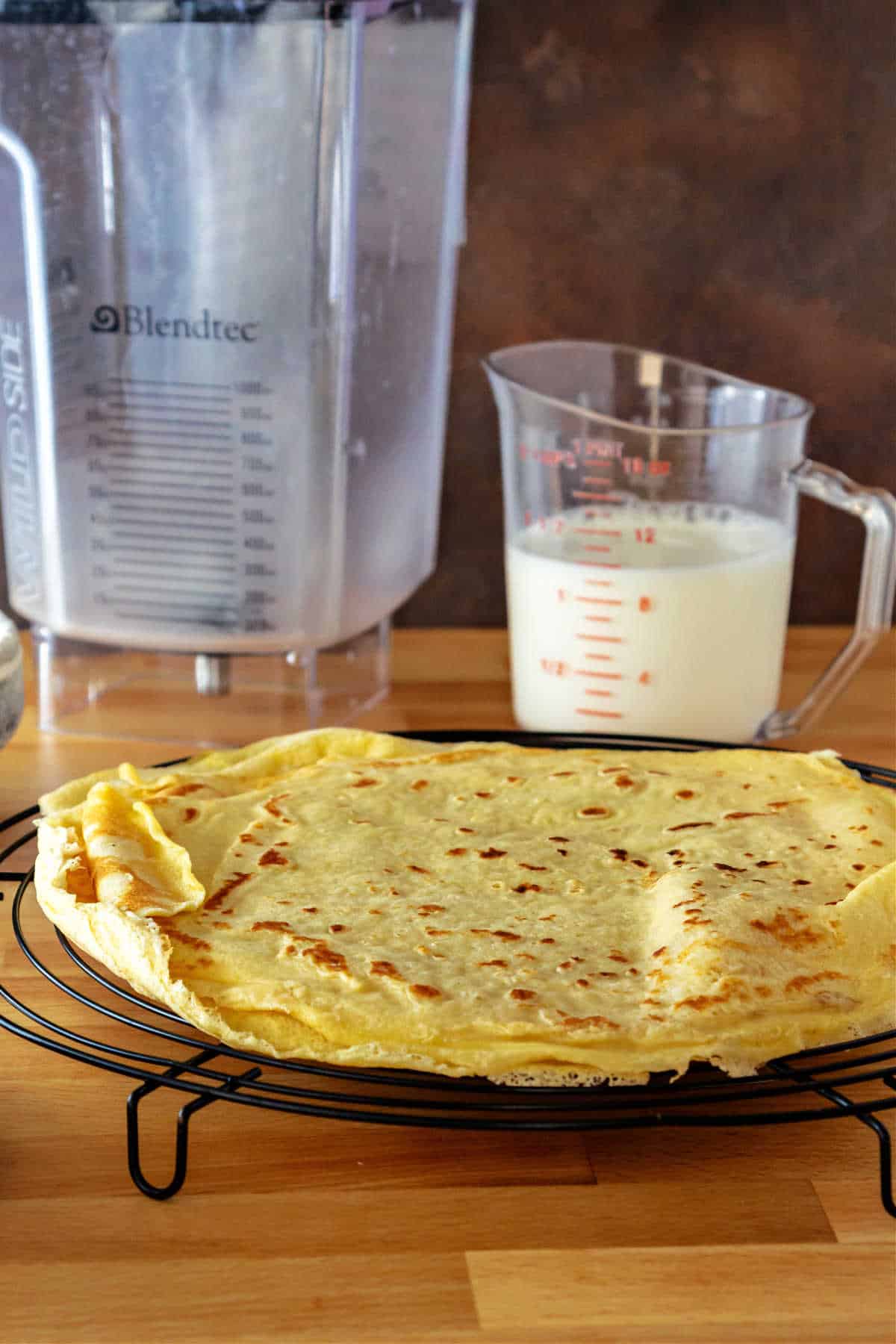
Finally got around to making these! After finally getting my temperature right, these crepes were absolutely perfect! The thinnest crepes I’ve ever made! We had ours with strawberries, lemon marscapone and whipped cream as well as ham, potatoes, and gruyere with a bechamel sauce.
Reader and Crepe Lover jessica
So glad I had the foresight to double the crepe recipe. Now I’ve got dinner for tonight, too!
If you already know how to make crepes and want to get straight to it, you can jump straight to the recipe.
Otherwise, let’s go some Crepe Info you may find helpful to read before tackling the recipe.
What Is a Crepe?
A crepe is a thin and lacy pancake that originated in France.
The batter is thin and eggy and yields a very thin, flexible, foldable pancake that can be filled with/wrapped around almost any filling you can think of.
Crepes can be sweet or savory, but generally, that designation is for the filling rather than the crepe batter itself.
Check out the section on “Four Recipes for the Price of One” to see how you can alter your crepe batter in different ways to get the results you want.
Crepes Vs Pancakes
Crepes are a type of pancake. You could say all crepes are pancakes, but not all pancakes are crepes.
When I say “pancake,” I’m talking about a traditional American pancake/flapjack.
Here are some similarities and differences between crepes and pancakes:
- Pancake batter is thicker than crepe batter
- Pancake batter must be mixed gently while crepe batter can be made in a blender
- Crepe batter has more eggs in it than pancake batter
- Pancakes cook up fluffy and rise as they cook. Crepes stay thin and lacy.
- You can roll and fold a crepe. Pancakes will tear if you try that sort of action with them. They’re too tender
- Pancakes are delicious. Crepes are delicious.
Arguably, crepes are more versatile than pancakes, because the filling options range from sweet to savory and from simple to complex.
Pancakes are generally served as a sweet breakfast treat, either with butter and maple syrup or with some other syrup and possibly fruit topping.
Why You Need to Make Your Own Crepes
Crepes are actually pretty easy to make.
One recipe will yield 7-8 crepes that are about 8-10″ in diameter, and you can easily make half a recipe if you have a small family.
And while you can buy crepes in some grocery stores, and you can get crepes out at some restaurants, here’s why I think you should make your own, at least once.
- You get to conquer a fear and mark a kitchen bucket list item DONE. Many people are afraid of crepes and making crepes.
I am here to help you find a good level of comfort with making these thin little pancakes so you can feel like a badass. You’re welcome. - You can make them any size you want. Want a little crepe? Use a small pan. Want a big old crepe? Use a larger pan.
Do you think the size of crepes you can get at the store is too stingy? Or too much? Make your own exactly the size you want. - Make them taste the way you want with the texture you want. Once you read this post and learn about the different ways to vary the texture of your crepes, you are free to experiment. You can add herbs and spices if you want also.
Once you understand how to make crepes, and why they’re made that way, you’ll be empowered to make all sorts of variations.
Poultry seasoning in crepes that you’re going to use for a chicken filling? You can do that. - Cinnamon in crepe batter that you’ll use to wrap around stewed apples? You can do that too!
Different Results with Different Ingredients
Most crepe recipes have the same basic ingredient list:
- flour
- eggs
- sugar
- oil/butter
- water/milk
- salt
I took those four ingredients and made four variations to see which one/s I preferred, and also to answer the burning question “Can you make crepes with self-rising flour?”
Each batch of crepes was subtly different, but I’d have been hard-pressed to tell the difference if I tried them on different days.
Still, it’s worth mentioning how changing the proportion of ingredients can affect the final result. Because knowledge is power!
Four Recipes for the Price of One
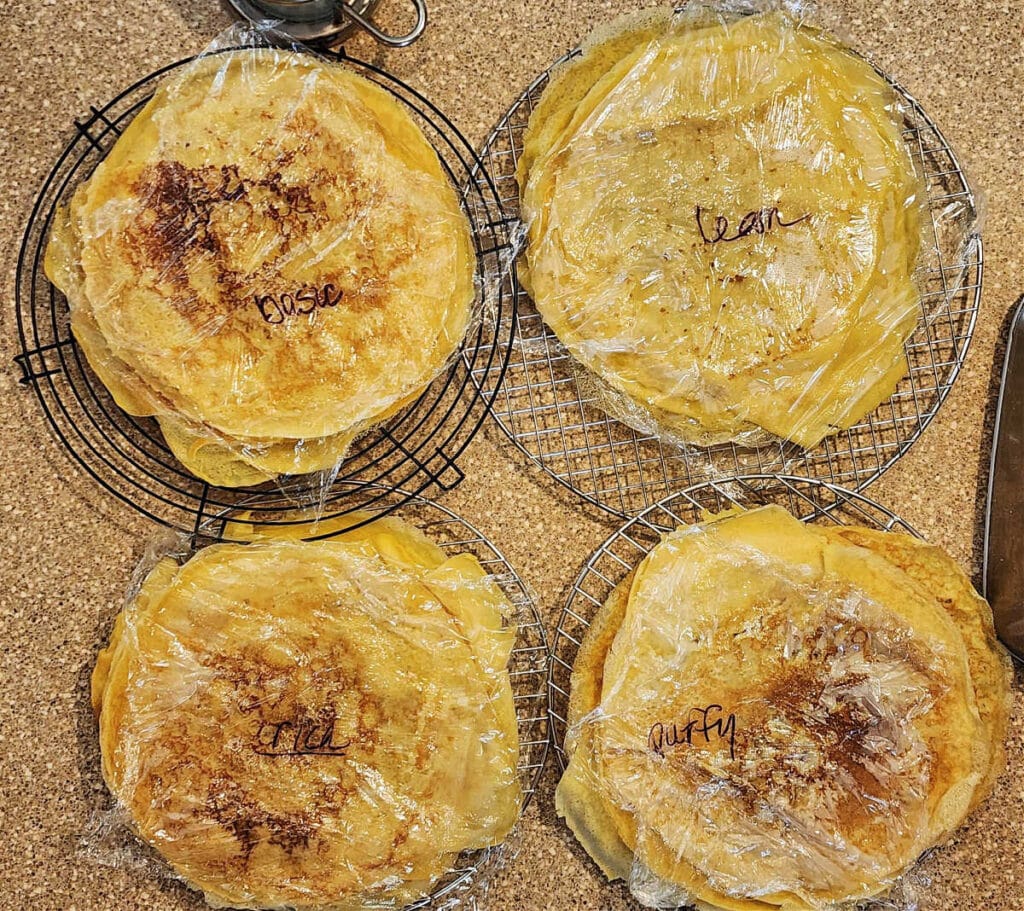
Here is the basic recipe I started with:
- 4.5 oz all-purpose flour
- 2 eggs
- 1 Tablespoon sugar
- 1/4 teaspoon Morton’s kosher salt
- 12 oz whole milk, cold
For those of you who like a good ratio, think 1 cup flour to 1 1/2 cups liquid, plus 2 eggs.
To scale, for each additional cup (4.5 oz) flour, add 2 more eggs, another 1 1/2 cups liquid, 1/4 teaspoons salt, and another tablespoon of sugar
For the lean crepes, I swapped out 6 oz cold water for 6 oz of milk and used no butter.
For the rich crepes, I added 1 1/2 Tablespoons of melted butter to the basic batter.
For the puffy crepes, I substituted self-rising flour for the all-purpose flour and went with 6 oz each water and milk.
The basic recipe will be in the recipe card, and the three variations will be in the notes section. The procedure is identical for all four formulas.
Taste and Texture Comparison
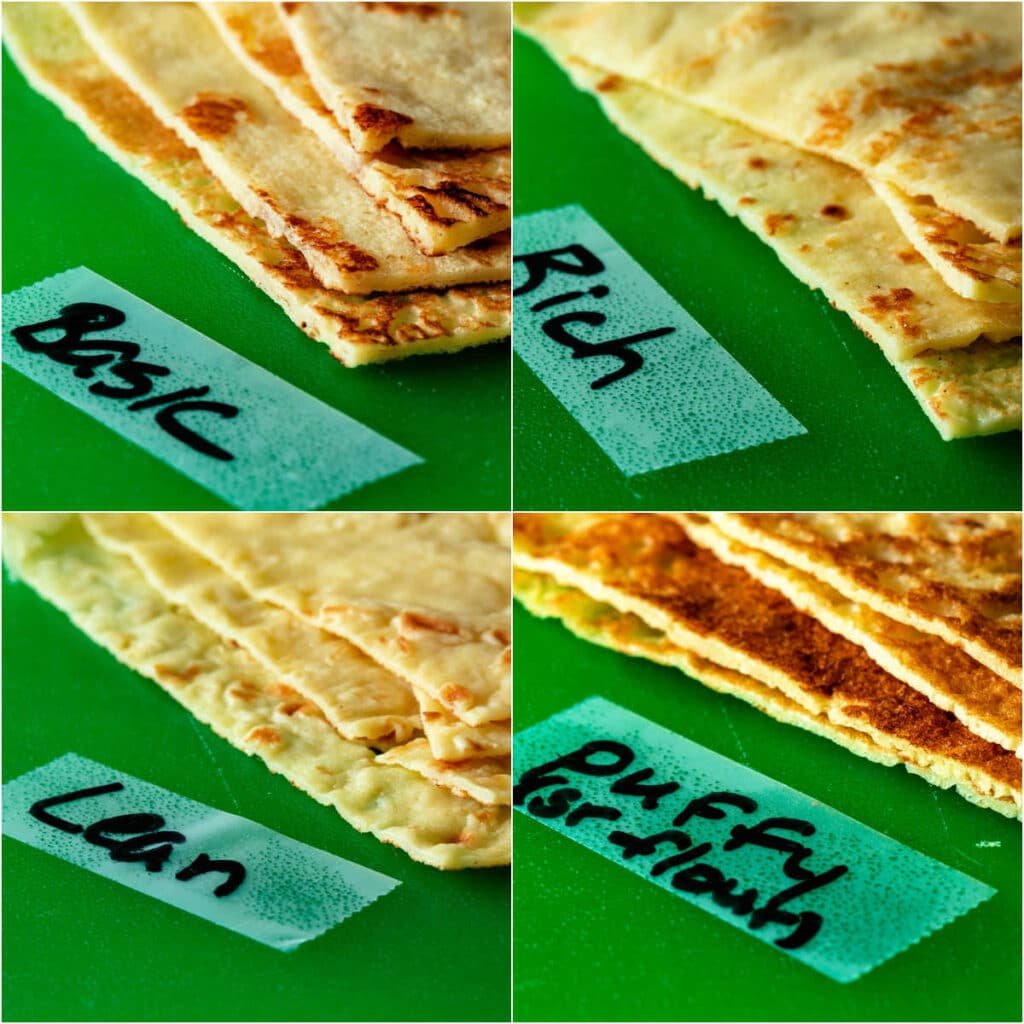
Note how “floppy” and thin the lean recipe is. They were definitely easy to work with, but they had less substance than the other three versions.
It’s hard to see because all four are so thin, but the basic crepes were thickest, followed by a tie between rich and puffy, and of course, the lean guys were the thinnest.
Crepes Made with Self-Rising Flour
When I poured the puffy batter into the pan, it got a lot of holes in it because of the leavening. In order to get a solid surface, I had to keep swirling the pan and then wait for a few seconds for the batter touching the pan to set up before pouring off any excess batter.
The finished crepes were much more akin to American pancakes than the other three versions, so if you are a fan of the texture of an American pancake but you really want to be able to fold one around some filling, the puffies will be your new best friend.
Personally, I want my crepe to be its own thing, so the puffies weren’t my preference. Not bad, and I am 100% eating them, but they won’t be my go-to recipe.
Of the four versions I made, my favorite is the basic recipe. Jeffrey preferred the lean recipe.
Rules
Based on our tasting, here are the Rules of Crepe Making:
- The more dairy, the sweeter, so using half milk/half water yields a less-sweet crepe than using all milk, even with all other ingredient amounts remaining the same.
- The leaner the batter, the thinner the crepe. I would not use any less than 50% whole milk in my batter so the crepes have enough substance to be manhandled a little bit.
- If using self-rising flour, you don’t need to add extra salt. These crepes were the closest to American pancakes since they contained some chemical leavening. They weren’t my favorite, but that doesn’t mean they were bad. None of the four were bad. “Puffy” crepes are most likely to have bubbles (thus holes) because of the leavening.
- There is no need to add fat to the batter. The fat just made the crepes a little bit more tender and richer, which also made them harder to turn. Besides, you cook crepes in butter.
Jenni Says: Sugar assists with browning, so rather than altering the amount of sugar, play with the amount of milk solids to make your crepes less sweet. If you want a sweeter crepe, try using part whole milk and part half and half.
Set Yourself Up for Crepe-Making Success
Okay, friends. This is where I try and pre-game with you so once you get to the recipe, you’re ready to cook.
If you are already a confident crepe maker, you can head straight to the recipe.
Otherwise, please stick around as I set you up for success in the best way possible, arming you with All The Knowledge.
What Is the Best Technique for Making Crepe Batter?
As far as I’m concerned, making crepes in a blender is definitely the way to go.
Unlike with American pancake batter, you don’t need to be gentle with crepe batter. Because crepes are so thin, the batter has to be smooth.
And the best way to get a smooth batter is to hit it with your blender.
Since crepes are so thin and are made with a liquid-heavy batter, they need something to hold them together.
Those somethings are eggs and gluten.
You want the eggs smooth, and you also want to develop as much gluten as possible.
This seems counterintuitive, because nobody wants a rubber crepe, but you do want a flexible crepe, one that you can wrap around a hot filling and not have it disintegrate.
What does that? Gluten does.
So, blender it is.
Jenni Says: Put your blender jar on your scale, weigh in each of your ingredients, then blend on medium speed for 30 seconds. Batter: done.
Don't get a blender only to make crepes. If you have a hand mixer or stand mixer already, you can make your crepe batter with one of those.
But if you already need a good blender for smoothies, frozen drinks, etc, the Ninja is a solid choice that won't break the bank. And it will blend your crepe batter really well, too.
Why Do You Let Crepe Batter Rest Before Using It?
One of the big rules of making crepes is to let the batter rest. I’ve read to rest your crepe batter anywhere from 30 minutes to overnight.
There are a few reasons to let your batter rest:
- To allow the flour to fully hydrate
- To allow the batter to have more body (goes along with 1.)
- To give the gluten a chance to relax a bit so your crepes are sturdy enough to flex, bend, and roll but not so sturdy that they bounce if you throw one on the floor
- To allow the bubbles to rise to the surface of the batter and pop, thus preventing crepes with tiny holes in them
Let your batter rest in the fridge for at least 45 minutes, and if you are planning a crepe-extravaganza for brunch, make the batter the night before so that, in the morning, you’re ready to crepe as soon as your pan is hot.
Jenni Says: Crepe batter should be about the consistency of heavy cream or Creme Anglaise. If it’s a little thick, add a little milk or water and whisk it in.
How to Set Up Your Crepe Cooking Station
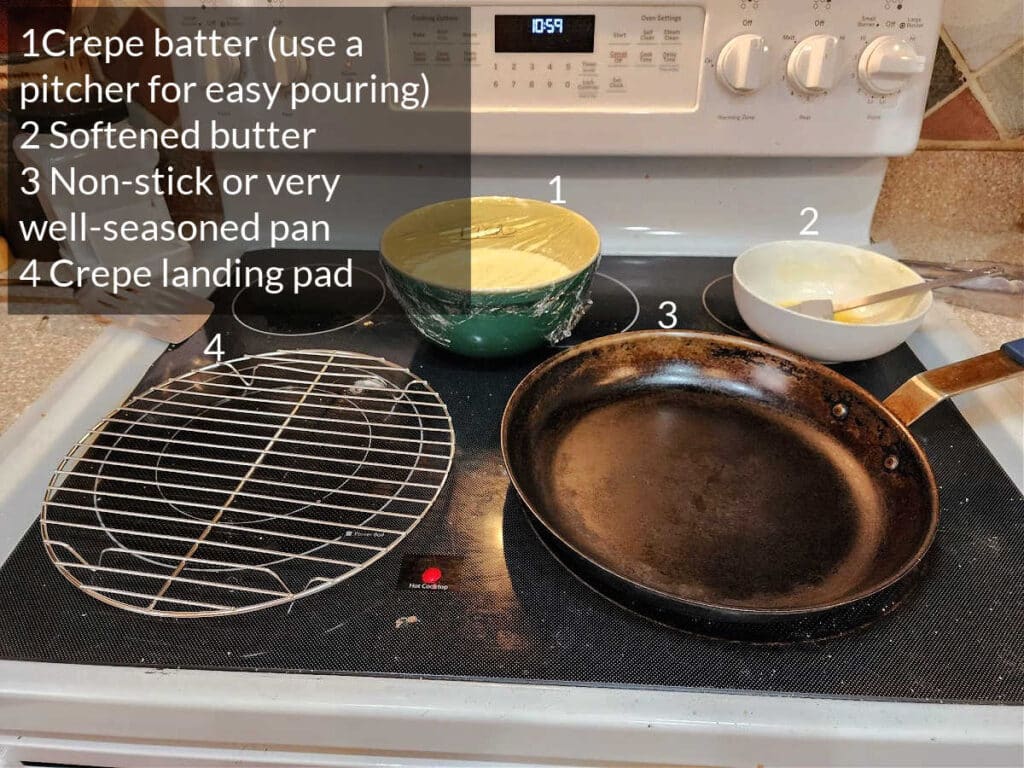
Can things go wrong when making crepes? Well, sure. You can minimize the opportunity for disaster by having everything set up and ready to go.
Would you like to save this post?
The above photo shows my setup for making crepes. Having a flat-top stove makes it really easy to set everything up in easy reach. You could also put a big cutting board over a couple of burners. That are turned off!
If you’re only making one batch of crepes, leave it in the blender jar or pour it into a pitcher. That way you can pour your batter with a minimum of mess.
Also have a bowl of very soft or melted butter and a little brush for application. I have a small silicone brush that works really well for this.
Crepe Station Rules to Remember
- Always use a nonstick or very well-seasoned pan.
- Heat the pan over medium heat until a little water sizzles when you flick it into the pan
- Butter your pan liberally between each crepe
- Pour in the batter in one go. If you pour and then pour again, you could disrupt the batter that is already setting, and your crepe will be too thick in spots
- Hold the pan up off the burner with your dominant hand and pour with your non-dominant hand.
- Immediately swirl the pan to distribute the batter evenly
- Tip the pan back over your pitcher and let any excess batter run back into the pitcher
- Allow the crepe to completely set on one side before attempting to turn it. The batter will no longer be shiny and the edges should start to curl up off the surface of the pan. This will take anywhere between 1 minute and about 90 seconds.
- Loosen the edges with a thin spatula, then either grab the edges with the fingertips and thumbs of each hand OR slide the spatula under the crepe and flip
- Adjust your heat if crepes are cooking too quickly. It’s also okay to move the pan off the heat to allow it to cool a bit.
Jenni Says: When your crepe is done, tip the pan over your “crepe landing pad,” and grab the near edge of the crepe with your fingers. Then, rather than pulling the crepe out of the pan, slide the pan back out from under the crepe.
What Can You Cook a Crepe In?
There is no need to buy a dedicated crepe pan. Nor do you need an electric crepe maker unless you really want one.
I recommend using a new–or at least un-scratched–non-stick pan OR a very well-seasoned carbon steel pan.
T-fal makes a solid product and their non-stick coating is really good. They are also reasonably priced. Use only silicone-coated tools to avoid scratching the non-stick surface, and one should last you years.
How Do You Keep Crepes from Sticking to the Pan?
Heating the pan prior to adding butter or batter is one of the best ways to keep food–crepes included–from sticking.
Heat your pan over medium heat for a good 5-7 minutes. The butter should sputter and sizzle when you brush it into your pan.
Do this right before adding your batter, not just once but before you cook each crepe.
Even over medium heat, pans will continue to get hotter, so don’t forget to adjust your temperature as you continue to cook your crepes.
For example, I started on medium, which on my stove is about a 6, but by the time I finished cooking all my crepes, I had dialed the heat down to a “3.”
How Do You Flip Crepes without Making a Mess?
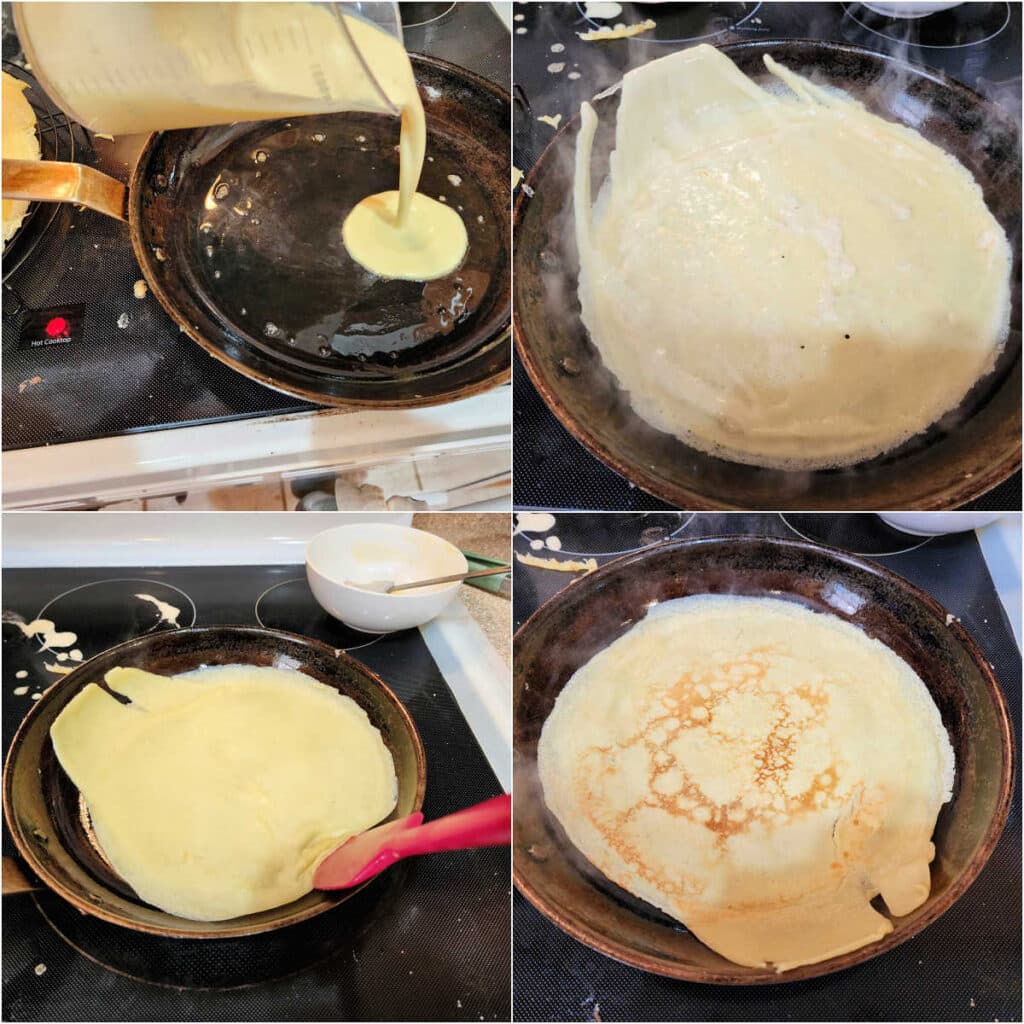
Helpful Tip: See how the batter is sloshed up the side of the pan? That’s from pouring excess batter back into the pitcher. I learned that in This Video.
This is good practice for folks (myself included) who don’t make crepes all the time and don’t correctly judge how much batter to use.
You can use this “edge” to help ease the crepe from the pan once it’s cooked.
The best way to flip without making a mess is to make sure the crepe is set and ready to be flipped before even trying.
The crepe should release pretty easily from the pan, especially once the edges begin to curl away from the pan.
Slide a thin spatula under the edge that is already most “lifted,” and then use the spatula to flip the crepe.
It may not be picture-perfect, but you will be able to straighten the flipped crepe out using the spatula and your fingers.
How to Make Crepes
These next sections will walk you through all the ingredients for crepes and give substitutions where possible.
I’ll run through the procedure again, give you some ideas for variations, tips for success, and serving suggestions.
Again, this post is very long, so if you don’t need all the supporting information, feel free to jump to the recipe.
Ingredients and Substitutions
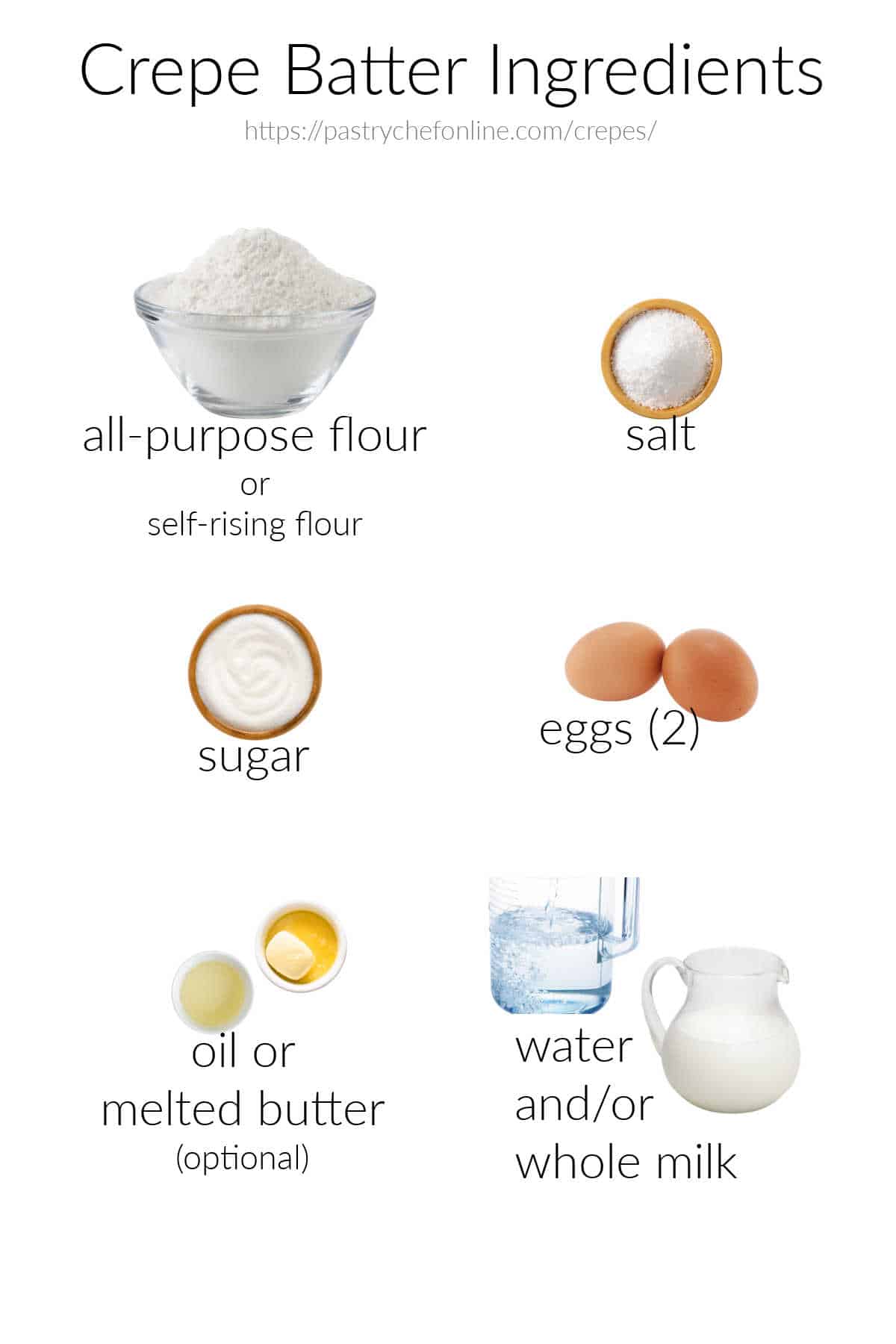
- flour: Stick with all-purpose unless you want puffy crepes, in which case, start with self-rising flour. Note that, if you use self-rising flour, you most likely won’t need extra salt, and your crepes will be a touch thicker and might have a few little holes in them. They will still be tasty and will be sort of a hybrid between an American pancake and a crepe.
- salt: Brings the flavors into focus. Don’t leave it out unless using self-rising flour
- sugar: Adds a touch of sweetness, but more importantly, it assists in browning. I wouldn’t leave it out, even for savory crepes, although you could reduce the amount to 1-2 teaspoons rather than 1 Tablespoon. You could experiment with using brown sugar instead (say for apple-cinnamon crepes) or a little touch of honey or maple syrup
- eggs: Eggs lend color and structure. Think of crepes as a thin custard that just happens to have flour in it
- oil or melted butter (optional): I did not find the rich crepes to be more delicious than ones I made without butter or oil, so I am calling this an optional ingredient. Butter or oil, you don’t need much. Remember you’re cooking your crepes in butter, and they will absorb a certain amount of that already as they cook
- water and/or milk: Do not use just water–your batter won’t have enough structure and will be too thin. But you can play with a mixture of 50% water/50% whole milk or consider using half and half or a touch of cream. Remember the texture of your batter needs to be like heavy cream, so using too much of a higher-fat dairy will make your batter too thick.
Procedure
I’ve gone into depth with some of the procedures earlier in the post, so this will be a quick overview as a refresher.
Here is my “elevator pitch” for how to make crepes:
- Make the batter in a blender.
- Let it rest.
- Heat your pan and have your batter, butter, and a place to stack the finished crepes all close at hand.
- Heat the pan.
- Sizzle in some butter.
- Pour in batter, swirl pan, and pour excess batter (if any) back into your pitcher
- Allow crepe to set up on the first side completely before attempting to flip it.
- Loosen the crepe with a thin spatula.
- Flip with your fingers or the spatula.
- Slide the pan out from under the finished crepe rather than trying to pull the crepe out of the pan.
Jenni Says: Crepes are too thin to keep warm in the oven. They’ll dry out. The heat from each crepe you add to your stack of finished crepes will keep the crepes warm for serving.
Equipment You May Need
We already took a look at pans and blenders, and believe it or not, for such a fancy-sounding recipe, you don’t really need a ton of equipment to make them
Crepes are really more about technique and the viscosity of your batter than they are about what you use to make them.
As long as your pan is nonstick and you heat it well before adding butter and then batter, you should be good to go.
If you want a spatula that is super thin and able to assist in flipping, and you don’t feel confident grabbing the edge of your crepe with your fingers, consider using a fish spatula to flip.
Aside from turning fish, a fish spatula is great for flipping other delicate foods like crepes. You may not need one all the time, but it is a great tool when you need to flip something fragile that could potentially fall apart.
Variations
As long as you don’t change the proportions of the main ingredients, you are free to play with flavors.
You can add:
- vanilla or another extract
- ground herbs and dried spices
- citrus zest
- your favorite spice blend
You can substitute:
- cocoa powder for 1/4 of the flour and add vanilla and some melted and cooled butter to the batter for chocolate crepes
Tips for Success
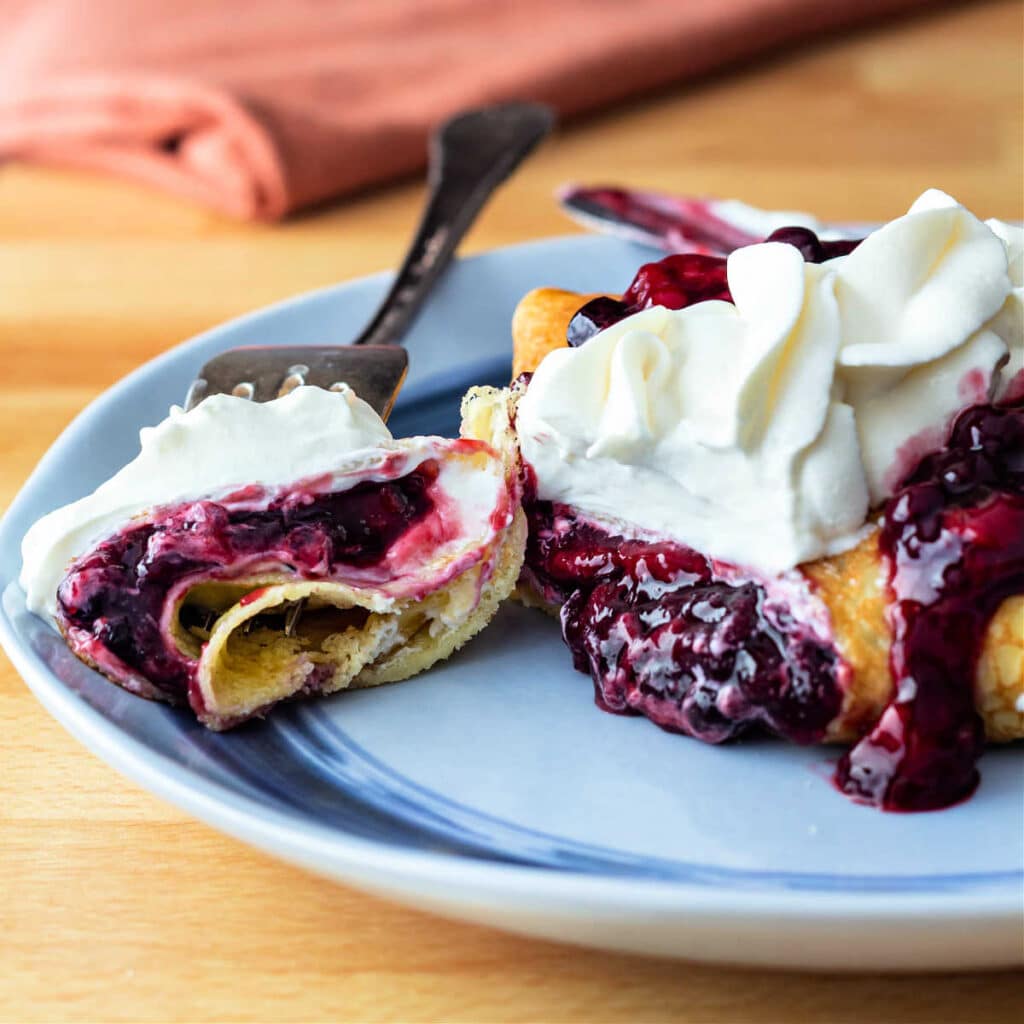
I’ve mentioned these tips before, but they bear repeating:
Heat your pan so that butter sizzles when you add it before pouring in your crepe batter.
To ensure thin crepes, especially for beginners, pour off any excess batter back into your pitcher.
When your crepe is done cooking, tilt the pan over and shake it gently so the crepe starts to slide out of the pan. Grab that end of the crepe and hold it still while you pull the pan out from under the crepe. This works much better than trying to pull the crepe out of the pan.
Crepe Q & A
The answer is a qualified yes. Similar to making crepes with self-rising flour, you will need to use more liquid and egg than called for in your mix. For a standard pancake mix that calls for 1 egg and 3/4 cup milk per cup of mix, double the eggs and milk (or use half milk/half water). Note that crepes with leavening might end up with tiny holes in them, so be sure to let the batter rest overnight before using.
Absolutely. You can make the crepe batter the day before cooking them, and you can also refrigerate crepes for 4-5 days before using.
Yes. You can cook them the day before, stack them, and refrigerate when completely cool either wrapped in plastic wrap or in a zip-top bag to use over the next few days.
Yes, crepes freeze very well. Separate each crepe with a piece of parchment, stack them, and freeze them in stacks of 8-10 in a large zip-top freezer bag. Be sure to press out as much air as possible before freezing. They’ll be fine for up to 8 weeks or so. Thaw overnight in the fridge before using.
Serving Suggestions
Fill your crepe with anything you can think of, either sweet or savory.
You love a particular sandwich? Put those fillings in a crepe for a fancy, savory treat.
For example, I had this Croque Madame crepe at a crepe restaurant.
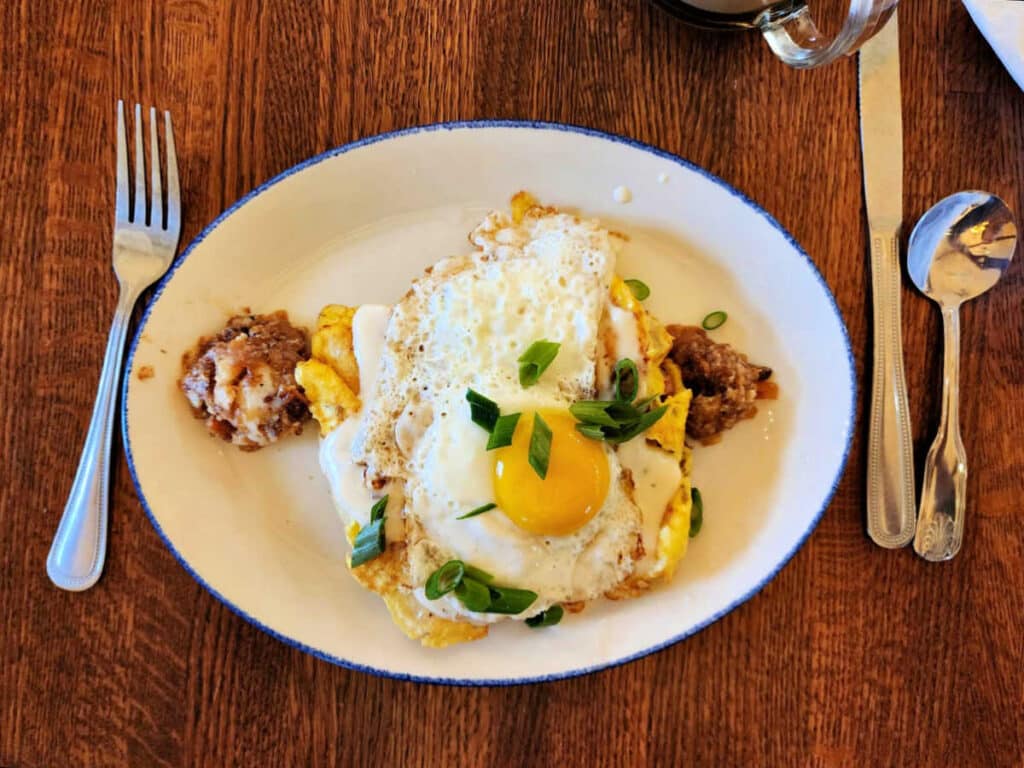
There’s ham and cheese inside of that guy plus bechamel sauce and a fried egg on top. So good!
I have a Monte Cristo Crepe recipe that is an Excellent use of your crepes. Look:
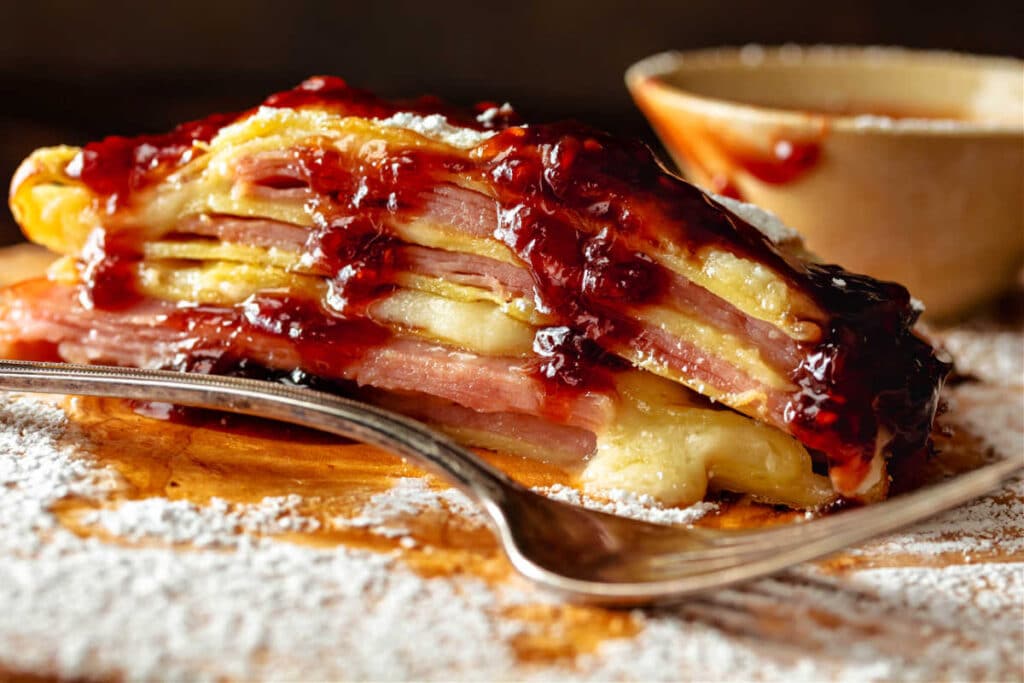
You really are only limited by your imagination.
For sweet fillings, you can make your fillings as simple or complex as you want.
I love a crepe with a little melted butter, a smear of cherry jam, and a little flaky sea salt.
Or try them filled with a smear or three of lemon curd or even lemon pudding.
Here’s a quick filling I whipped up a couple of days ago: frozen blueberries and strawberries cooked in water, sugar, a little balsamic vinegar, and cornstarch until jammy and thick plus hand-whipped cream into which I whisked some Greek yogurt for a little tang. Or try a schmear of either my French-style strawberry preserves or blueberry jam.
An easy and lovely combination.
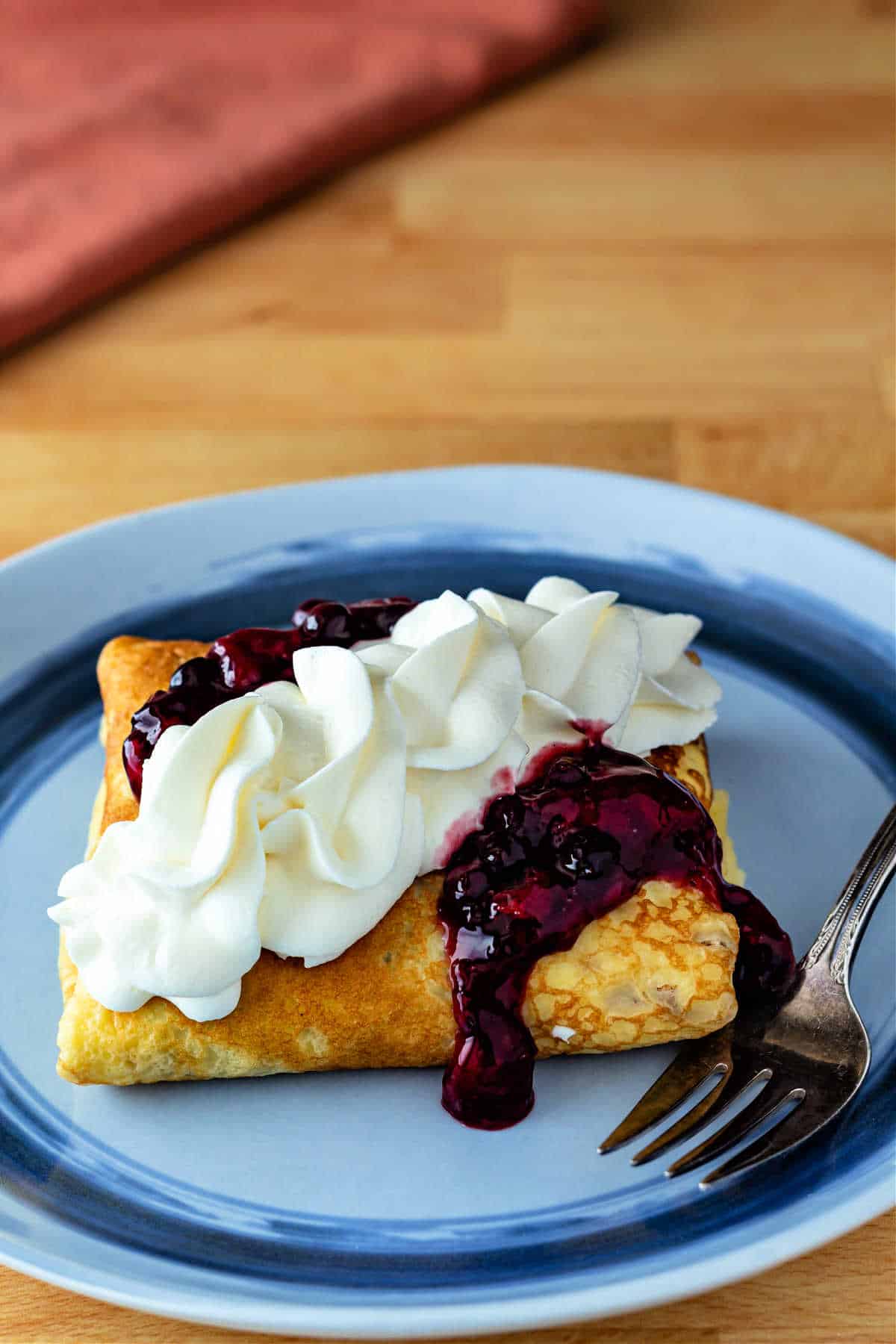
Questions
It will help me and other readers so much if you take a moment to rate and leave a review for this recipe.
You can use the stars to rate 1-5 (5 is best), and leave a review in the comments. It helps me make adjustments if any are needed, and comments help others decide whether the recipe is worth making.
Other ways to share include pinning, and/or sharing on your favorite social media platform.
Thank you so much for taking the time!

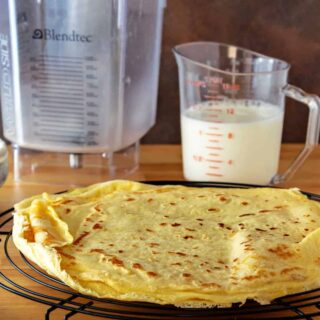
How to Make Crepes (Four Ways)
Would you like to save this post?
Ingredients
Basic Crepe Batter (See Notes for Variations)
- 130 grams all-purpose flour 4.5 oz or about a cup
- 2 large eggs
- 1 Tablesppon sugar
- ¼ teaspoon kosher salt I use Mortons
- 340 grams cold milk 12 oz or 1 1/2 cups
- Butter for cooking about 2 teaspoons per crepe
Instructions
- Measure all ingredients into a blender jar and blend on medium speed for about 30 seconds.
- Refrigerate for at least 30 minutes up to overnight.
- When time to make crepes, have your batter, your pan, some melted butter and a silicone brush, and a place to put your cooked crepes all within easy reach.
- Heat pan over medium heat until water sizzles when you flick a little into it.
- Brush in a little bit of softened butter, then pour in about 1/4 cup crepe batter.
- Immediately swirl the pan to distribute the batter evenly all over the bottom of the pan, then pour any excess back into your pitcher of batter.
- Allow the crepe to cook for about 90 seconds, or until the edges start pulling back from the pan.
- Carefully loosen the crepe with a thin spatula, and flip either with your fingers or with the spatula.
- Cook on the other side for 30-60 seconds.
- Carefully remove the cooked crepe to your "landing pad."
- Repeat with the remaining batter.
- You should be able to make 7-8 8-9" crepes. Batter doubles easily.
- See Notes for Variations
Did You Make Any Changes?
Notes
Variations
Rich Crepes: Add 1.5 oz melted and cooled butter or oil to the batter Lean Crepes: Substitute half the whole milk for water Puffy Crepes: Substitute self-rising flour for the all-purpose flour with whichever version you decide to makeWhy To Let Your Batter Rest
There are a few reasons to let your batter rest:- To allow the flour to fully hydrate
- To allow the batter to have more body (goes along with 1.)
- To give the gluten a chance to relax a bit so your crepes are sturdy enough to flex, bend, and roll but not so sturdy that they bounce if you throw one on the floor
- To allow the bubbles to rise to the surface of the batter and pop, thus preventing crepes with tiny holes in them
Crepe Q & A
Can you make crepes with pancake mix?The answer is a qualified yes. Similar to making crepes with self-rising flour, you will need to use more liquid and egg than called for in your mix. For a standard pancake mix that calls for 1 egg and 3/4 cup milk per cup of mix, double the eggs and milk (or use half milk/half water). Note that crepes with leavening might end up with tiny holes in them, so be sure to let the batter rest overnight before using. Can crepes be made ahead of time?
Absolutely. You can make the crepe batter the day before cooking them, and you can also refrigerate crepes for 4-5 days before using. Will crepes keep overnight?
Yes. You can cook them the day before, stack them, and refrigerate when completely cool either wrapped in plastic wrap or in a zip-top bag to use over the next few days. Can crepes be frozen?
Yes, crepes freeze very well. Separate each crepe with a piece of parchment, stack them, and freeze them in stacks of 8-10 in a large zip-top freezer bag. Be sure to press out as much air as possible before freezing. They’ll be fine for up to 8 weeks or so. Thaw overnight in the fridge before using.
Nutrition
Thanks for spending some time with me today.
I hope you enjoy the crepes. Please let me know what you decide to fill them with!
Take care.

Hi, y’all! I hope you’ve enjoyed this post and hopefully also learned a thing or two.
If you like my style, I invite you to sign up for my occasional newsletter, The Inbox Pastry Chef.
Expect updates on new and tasty recipes as well as a bit of behind-the-scenes action. I hope to see you there!



Join in Today!
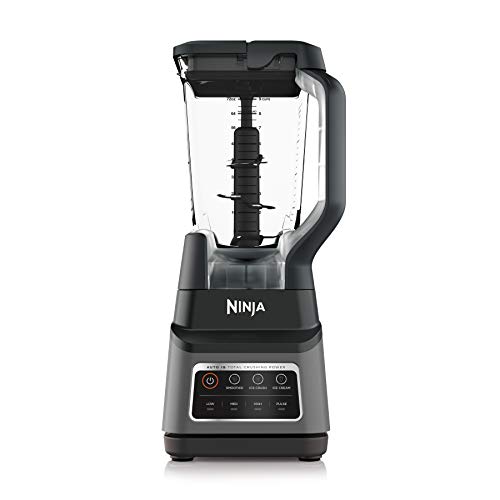



Finally got around to making these! After finally getting my temperature right, these crepes were absolutely perfect! The thinnest crepes I’ve ever made! We had ours with strawberries, lemon marscapone and whipped cream as well as ham, potatoes, and gruyere with a bechamel sauce.
So glad I had the foresight to double the crepe recipe. Now I’ve got dinner for tonight, too!
I don’t know how I haven’t responded to this comment for so long–I’m sorry, Jessica! I’m thrilled you love the crepes, and I really love the fillings you’ve used, both sweet and savory!